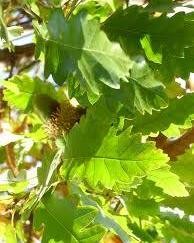Turkey oak
(Castanopsis javanica)

Description
Quercus cerris, the Turkey oak or Austrian oak, is an oak native to south-eastern Europe and Asia Minor. It is the type species of Quercus sect. Cerris, a section of the genus characterised by shoot buds surrounded by soft bristles, bristle-tipped leaf lobes, and acorns that usually mature in 18 months. Quercus cerris is a large deciduous tree growing to 25–40 m tall with a trunk up to 2 m diameter. The bark is dark grey and deeply furrowed. On mature trees the bark fissures are often streaked orange near the base of the trunk. The glossy leaves are 7–14 cm long and 3–5 cm wide, with 6–12 triangular lobes on each side; the regularity of the lobing varies greatly, with some trees having very regular lobes, others much less regular. The flowers are wind-pollinated catkins, maturing about 18 months after pollination; the fruit is a large acorn, 2.5–4 cm long and 2 cm broad, bicoloured with an orange basal half grading to a green-brown tip; the acorn cup is 2 cm deep, densely covered in soft 4–8 mm long 'mossy' bristles. First year acorns are very bitter, but are eaten by jays and pigeons; squirrels usually only eat them when other food sources have run out. The tree harbours the gall wasp Andricus quercuscalicis whose larvae seriously damage the acorns of native British oaks. In 1998, the Ministry of Defence ordered the felling of all Turkey oaks on its UK bases. The species' range extended to northern Europe and the British Isles before the previous ice age, about 120,000 years ago. It was reintroduced in the United Kingdom and in Ireland in the eighteenth century as an ornamental tree, its gall wasps now provide early food for birds. Turkey oak is widely planted and is naturalised in much of Europe. This is partly for its relatively fast growth. It is used as an ornamental, and as a coastal windbreak. The wood has many of the characteristics of other oaks, but is very prone to crack and split and hence is relegated to such uses as fencing. Several cultivars have been selected, including 'Variegata', a variegated cultivar, and 'Woden', with large, deeply lobed leaves. Turkey oak readily hybridises with cork oak (Q. suber), the resulting hybrid being named Q. × crenata Lam. This hybrid occurs both naturally where its parents' ranges overlap in the wild, and has also arisen in cultivation.
Taxonomic tree:







